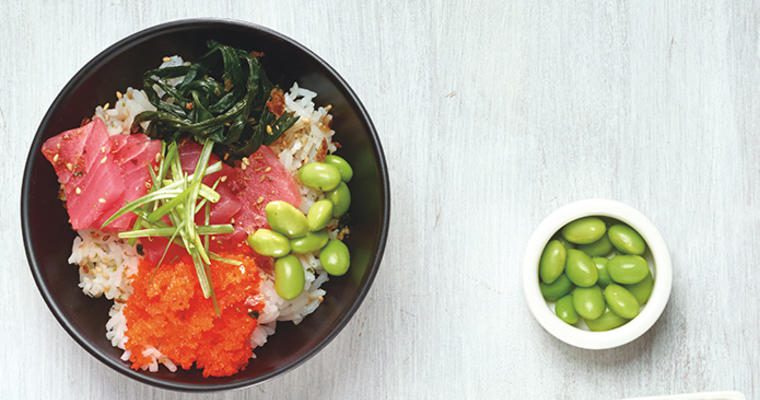Poke (pronounced “poh-kay”) is a Hawaiian dish dating back centuries, when fishermen would cut up the catch of the day and season it with ingredients at hand such as seaweed, sea salt and kukui (candlenuts). As the dish evolved, picking up outside cultural influences (such as shoyu and sesame oil), it became deeply rooted in the lexicon of Hawaiian comfort food. Now it’s so common on the islands that you can find several freshly made varieties at any local grocery store. Poke’s flexibility as well as its health halo and color palette has skyrocketed this dish onto the mainland; it’s a menu opportunity that has quickly gained national attention.
“It’s not very often that we see this much activity around a particular dish,” notes Gordon Food Service Corporate Executive Chef Gerry Ludwig, CEC.
In its most authentic contemporary form, poke is a dice of raw seafood—typically tuna, but often salmon or shellfish—dressed with soy sauce and topped with chopped candlenuts (kukui) or macadamia. Regardless of variety, the seafood’s quality is of utmost importance. Everything should be impeccably fresh and free of gristle. The fish should be buttery soft and taste of the ocean, clean and subtly sweet.
Be sure to buy from a trusted source as quality grades are based on each packer’s internal standards. “One packer’s AAA quality could be another packer’s A quality,” explains Gordon Food Service Seafood Category Analyst Jennifer Ostrander. “The different grades/sashimi designation mean nothing. What’s important and regulated is parasite destruction, and every packer should have a parasite destruction letter as it applies to tuna.”
Perfecting poke
Keep it simple. Start with the freshest seafood. Adding too many toppings or sauces can drown out the fresh fish taste, but a dash of sweet-salty dressing, or a touch of sesame oil with simple toppings, elevates the fish flavor without obscuring it.
Deliver on the value equation. Almost exclusively, fast-casual concepts serve their poke on a bed of rice or fresh salad greens; the added bulk satisfies the value equation and turns poke into a quick all-in-one meal. Full-service casual restaurants have the advantage of not having to worry about “bulking up” poke and can serve the dish in its purest form, allowing the fish to shine.
Prepare to order. While most fast-casual spots toss the fish with the dressing in batches to speed up service, this has a significant impact on the fish’s flavor. “We can say this with certainty,” Ludwig explains, “because one spot—Mainland, in Los Angeles—stood out by tossing fish to order. The difference in quality cannot be overstated.”
The bottom line? Poke is about flavor, not portion size. Using superior, high-quality fish and seafood, properly dressed and not overloaded with toppings, is the key to taking advantage of this menu opportunity with a poke that stands out from the crowd.
Five ways to mix and match poke
- Protein. The most popular is tuna (yellowfin or hibachi). Other great options: raw salmon, scallops, cooked crab, lightly poached shrimp or poached octopus.
- Dressing. Use soy, shoyu or ponzu sauce, sesame oil, rice vinegar, fresh citrus juice, gochujang and chili oil for a range of combinations.
- Vegetable garnish. Seaweed, cucumber, avocado, edamame, scallion, sweet onion and thinly sliced jalapeños are all common, but stick to one or two at a time.
- One crunchy element. Macadamia nuts, kukui, peanuts, cashews, fried lotus root, crispy fried onions or shallots enhance poke’s mouth feel.
- Final touches. Fish roe (e.g., tobiko), wasabi or Sriracha mayonnaise, sesame seeds or a sprinkle of furikake seasoning.




























